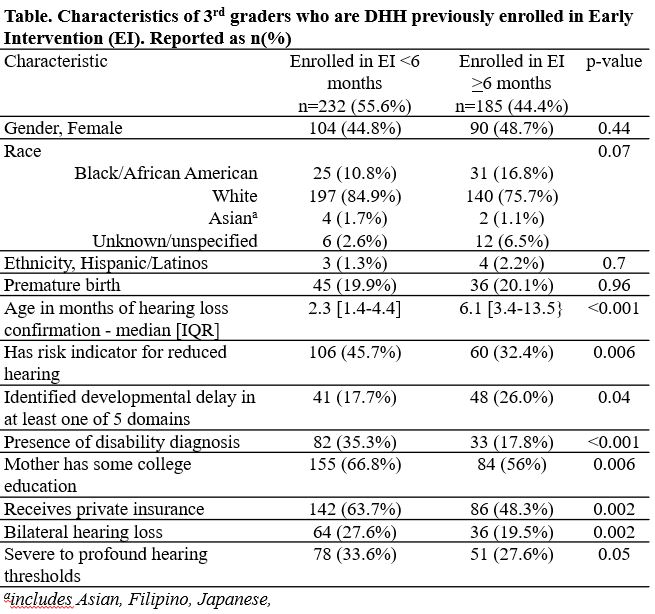Public Health & Prevention 3
Session: Public Health & Prevention 3
777 - Impact of pandemic on 3rd grade reading levels for children who are deaf/hard of hearing: Is EI by 6 months protective?
Monday, April 28, 2025
7:00am - 9:15am HST
Publication Number: 777.5184
Jareen Meinzen-Derr, Cincinnati Children's Hospital Medical Center, Cincinnati, OH, United States; Susan E. Wiley, Cincinnati Children's Hospital Medical Center, University of Cincinnati, Cincinnati, OH, United States; Elodie M. Betances, Cincinnati Children's Hospital Medical Center, Cincinnati, OH, United States; Cassandra Conrad, Cincinnati Children's Hospital Medical Center, Cincinnati, OH, United States; Jayna Schumacher, Cincinnati Children's Hospital Medical Center, Cincinnati, OH, United States
- JM
Jareen Meinzen-Derr, PhD, MPH (she/her/hers)
Professor
Cincinnati Children's Hospital Medical Center
Cincinnati, Ohio, United States
Presenting Author(s)
Background: Research shows that COVID-19-related school closures in spring 2020 significantly delayed reading progress in younger students, especially 2nd and 3rd graders.
Objective: To evaluate a) the pandemic’s impact on reading in 3rd graders who are deaf/hard of hearing (DHH) and b) whether this differed by early intervention (EI) enrollment age.
Design/Methods: This longitudinal study examined data linked across three state agencies on reading proficiency for children with permanent hearing loss identified through newborn screening born in Ohio between 2008 and 2014. Reading skills were measured in 3rd grade via standardized tests and categorized as limited, basic, proficient, accomplished, and advanced. The analysis compared reading skills assessed during pre-pandemic (2016-2019) and pandemic (2020-2021) school periods. Multiple logistic regression evaluated the pandemic’s impact on reading proficiency based on EI enrollment age ( < 6 or >6 months), accounting for confounders such as hearing levels, disability status, insurance, and maternal education. Results were reported as odds ratios (OR) and 95% confidence intervals (CI).
Results: Among 1262 DHH children previously enrolled in EI, 417 were 3rd graders with 232 (55.6%) previously enrolled in before age 6 months. During the pandemic, 52% of students who were DHH were in 3rd grade. Children enrolled earlier in EI were more likely to have a risk indicator for hearing loss, disability diagnosis, maternal education that included some college, and private insurance (Table). Pre-pandemic, 60% of all 3rd graders who were DHH had proficient (or better) reading skills, which dropped to 43% during the pandemic (p=0.0007). Among earlier EI students, the percentage of children with limited reading skills rose from 21.1% to 33.3% during the pandemic, a 58% increase (Figure). This trend was similar to all Ohio 3rd graders; 31.1% had limited reading skills during the pandemic. Among later EI students, the percentage with limited reading proficiency rose from 23.1% to 48.9% during the pandemic (a 112% increase). Earlier EI students assessed during the pandemic were twice as likely (OR 2.0, 95%CI 1.07, 3.88) to have limited reading proficiency compared to pre-pandemic while later EI students were four times as likely (OR 4.4, 95%CI 2.08, 9.35).
Conclusion(s): The pandemic negatively impacted reading skills of 3rd graders who are DHH. Starting early intervention before age 6 months could lessen these impacts, offering a stronger educational foundation for these children to stay academically on track, especially during crises.
Figure. Reading proficiency pre and during pandemic for DHH 3rd graders who received EI
.jpg)
Characteristics of 3rd graders who are DHH previously enrolled in Early Intervention

Figure. Reading proficiency pre and during pandemic for DHH 3rd graders who received EI
.jpg)
Characteristics of 3rd graders who are DHH previously enrolled in Early Intervention


